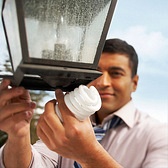What can you do?

Changing small habits is actually one of the most challenging aspects of energy conservation, but it can also make the most impact on energy usage and environmental damage. The best way to save energy is to not use as much of it in the first place! Do lights need to be on all the time? Is it reasonable that you dress a little warmer in winter and compensate by using your heating system less? Could you walk/cycle or take public transport more frequently? Did you know that 9% of our yearly electricity bill can be made up of items left on standby mode?
The following are some actions that you can apply in the home to help save energy (and money!):
Turn down the heat
Many households have their central heating set higher than they need it, without knowing that they are doing it. You could try turning your room thermostat down by one degree; leave it at this temperature for a day and if you still feel warm enough, try turning it down another degree. Continue to do this for as long as you feel comfortable. Every degree that you turn it down could save you around £60 a year on your heating bill.
Turn off lights
Make sure you turn all lights, appliances and chargers off when they are not being used. If you turn a light off for even a few seconds, you will save more energy than it takes the light to start up again no matter what sort of lights you have. And nearly all electrical and electronic appliances can safely be turned off at the plug without upsetting their systems - the only exceptions are satellite and digital TV recorders which should be left plugged in so they can keep track of any programmes you want to record - but check the instructions on any appliances you aren’t sure about. A family could save around £40 a year just by remembering to turn things off if they don't already do this.
Caution in the kitchen
You could save roughly £35 a year just by being careful about how you use your kitchen appliances:
- Set your washing machine to wash at 30°C.
- Only use your tumble dryer when you can’t dry your clothes outside.
- Don’t fill your kettle right up every time - just boil the amount of water that you need.
Next steps
Most households could do steps one, two and three without having to spend a penny. So if you’re not doing them already, start now and you could save up to £135 a year - that’s more than home energy bills went up at the last big price rise./p>
Now let’s re-invest some of those savings in some simple measures that will pay back quickly, and see if we can double those savings...
Get an eco-shower head
If you’ve got a shower that takes hot water straight from your boiler or hot water tank (rather than an electric shower) then you may be able to fit a water-efficient shower head and cut your hot water use without noticing any difference in your shower. An eco-shower head will cost around £27 and a family of four will save around £72 a year on water heating and another £78 on water bills if they have a water metre.
Fit a tank jacket
If you have an uninsulated hot water cylinder you could start saving now by fitting a tank jacket. And while you’re doing that, insulate any exposed hot pipework around the cylinder and around the boiler. It’s easy to fit yourself, the materials for everything should only cost around £25, and you’ll save roughly £55 a year.
Fix draughts
Unless your home is very new, you’re likely to be losing some heat through draughts around doors and windows, gaps around the floor, maybe up a chimney, and a variety of other little holes around the house. You could counter a lot of these draughts with some proper draught-proofing products for the doors and windows, seal your skirting boards with silicone sealant, and fitting chimney balloons or sealed fire guards. Depending on your house, materials could cost up to £160, but you could save up to £90 a year so they’ll pay for themselves in less than two years.
More eco-friendly lighting
Have you changed all your light bulbs for low-energy ones? Even the halogen spots? You can now get LED spotlights that are bright enough to replace halogens, as well as regular energy saving bulbs (CFLs) for almost everything else. They come in a variety of shapes, sizes and fittings. You can look for the Energy Saving Trust Recommended logo to be assured of light quality and lifetime. If the average household replaced all their remaining old-fashioned bulbs with CFLs and all their halogens with LEDs it would cost around £125 and save around £55 a year.
Total savings
Add them all together and - well, you can’t really add them all together, because very few houses could do all of these, and some of them overlap a little, but many households could save between £150 and £300 a year while spending less than that to fit everything in the first year. Remember that the savings you can achieve will depend on what you’re currently doing and how many changes you choose to make.
This information is from the Energy Saving Trust; you can view their website for more information at the Energy Saving Trust.

